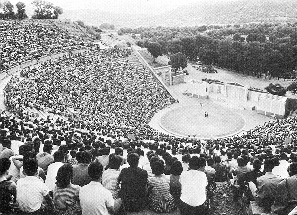
(click for larger image)

The Theater of Dionysos in Athens could seat approximately 15 thousand in simple stone benches on the slope of the Acropolis. The seats partially surround the orchêstra, which is a dancing area of packed earth, about 20m in diameter. This is where the chorus spends most of its time. In its center is the altar of Dionysos (about 1m high). On either side of orchêstra is an entry path (eisodos), used both by the audience to get to its seats and by the chorus for its entries and exits. Some scholars think that there was a small stage (8X3m., 1m high) between the orchêstra and skênê (not shown on diagram); it would have steps down to the orchêstra.
At the back of the dancing area is the stage building (skênê = tent or hut), perhaps 12m wide and 4m high, which served a number of functions. First, it contained the actors' dressing rooms. Second, it formed a backdrop to the stage and could be decorated to represent a temple, house, etc. In the center it had a large, double-leaved door, which could be used for entries and exits. Also, a 2.5X1.5m platform (the "rollout") could be rolled out from these doors to exhibit a tableaux of what had taken place inside (e.g. Clytaemestra standing over the bodies of Agamemnon and Cassandra). There were also two smaller doors in the wings of the stage building for entries and exits. Third, characters could appear on the top of the stage building, for example, the watchman in Agamemnon, but more frequently gods appeared there. On the right side of the stage was a crane (the "machine"), which could be used for flying gods (the proverbial deus ex machina).
The playwrights often exploited the fact that the gods appeared on high, the heroes or other important individuals appeared on the stage or before the backdrop, and the chorus (representing ordinary people) appeared on the dancing floor in the midst of the audience.

The theater at Epidauros
(which shows how the Theater of Dionysos looked in the classical period)
Make sure to see the Reconstruction of the Ancient Theater of Dionysos, which however represents the theater at a later time.
 Send comments about this page
Send comments about this page